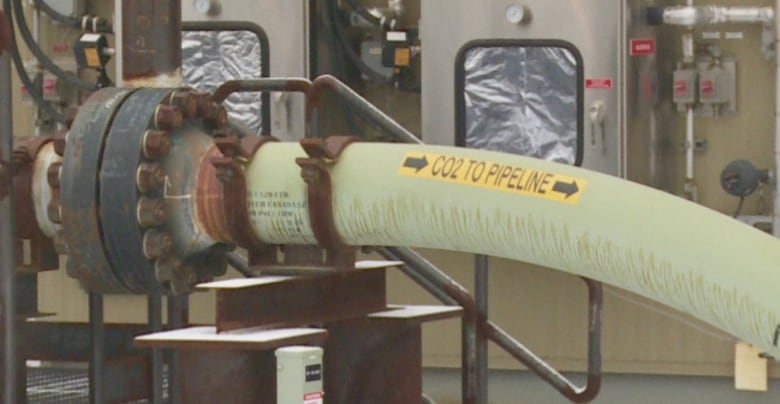Carbon capture industry could grow if taxes rise, expert says
Avoiding high emission taxes would make innovative alternatives more economical

Considering all the recent debate about carbon taxes, climate change and greenhouse gas emissions, there's been little discussion about one of the methods of containing those gases — carbon capture and storage (CCS) facilities.
Four such projects are already operating or being developed in Canada. But an industry expert who worked on one of them says future growth depends on carbon taxes rising to around $100 a tonne.
If taxes rise to that level, companies that capture their carbon emissions instead of dumping them into the atmosphere could save substantial amounts of money. In turn, that could alleviate the biggest challenge CCS projects face — the need for significant government funding to help cover the costs.
In the first 13 months of operating, Shell's Quest project near Edmonton has taken 1.3 million tonnes of carbon dioxide emissions from the company's bitumen upgrader and stored it two kilometres underground.
The $1.3-billion project was paid for primarily by governments. Alberta gave $745-million and Ottawa chipped in $120-million.

Shell is focused on operating the facility as efficiently as possible, but the company is also pondering when it might construct more CCS facilities in the province.
"Internally, we would look at the next one being more commercial and we wouldn't need government funding," said Tim Wiwchar, Shell's oilsands portfolio manager and former Quest project lead. "You're probably looking at five or 10 years until the next one."
An escalating carbon tax
The further carbon taxes rise, the more economical carbon capture and storage projects become.
Shell doesn't make money from Quest, but the project reduces how much the company has to pay in carbon pricing. Alberta will charge $20 a tonne in 2017 and $30 a tonne in 2018. The federal government wants a carbon tax of $50 a tonne by 2022. Shell already pays Alberta's carbon tax, which targets big emitters.
We would look at the next one being more commercial and we wouldn't need government funding.- Tim Wiwchar, Shell Canada
If Quest had been constructed without government funding, Shell says it would have needed a $100 a tonne carbon tax to cover the capital cost of construction and operating expenses. Shell estimates additional facilities will cost 30 per cent less because of efficiencies they've identified through the construction and operation of the first project.
"It all depends on the carbon tax. If you go to $50 per tonne, or more if it escalates, you start to close that gap," Wiwchar said, during a tour of the Quest project last month.

Political buy-in
In recent years, politicians have expressed varying opinions on CCS as a way of reducing carbon emissions and addressing climate change. Saskatchewan's premier has been the biggest proponent, and sees Canada exporting the technology around the world.
"SaskPower is engaged with interests around the world who are taking a look at it," Brad Wall said at the UN climate change conference in Paris last year.

The late Jim Prentice, former Alberta premier, was not convinced the technology was worth the investment, saying in 2014 that "it's not capable of achieving the reductions in emissions that are required, and it is expensive, and in certain contexts, it's quite unproven."
The current Alberta NDP government supports the two CCS projects in the province, but won't commit to funding other proposals.
If the price on carbon rises high enough, companies like Shell shouldn't have to rely on politicians to obtain hundreds of millions of government dollars to build new CCS projects.
Selling vs. storing
Another potential source of revenue is selling the CO2 instead of storing it in the ground. CO2 can be used in the production of fertilizer, pharmaceuticals and methanol. In Saskatchewan, CO2 is sold to oil companies for advanced oil recovery, which is a method of pumping CO2 into the ground to push out more oil.
"There are other means to generate revenue, other than carbon price, or in addition to carbon price. Now all of a sudden you can pay for a project without government funding," said Wiwchar.
"We get contacted quite a bit now. There are people wanting to grab our industrial source of CO2, so they can test it out on their technology."

In Saskatchewan, SaskPower operates the $1.5 billion Boundary Dam project, which captures emissions from a coal power plant. SaskPower declined an interview but said it will make a decision about whether to build CCS facilities at its six other coal power plants "in late 2017 or early 2018."
The Crown corporation would not discuss whether a carbon tax would influence its decision about future CCS projects.
Two other major CCS projects are under development. Spectra's project in Fort Nelson, B.C., is a gas processing plant retrofit. The company says the project is currently on hold. And the Alberta Carbon Trunk Line gathers CO2 from an oilsands refinery and a fertilizer plant before transporting it to be used for enhanced oil recovery.
Meanwhile, the head of Shell Canada views CCS as a way to help the world shift away from coal, oil and natural gas over the next several decades.
"Even in the transition we will be in for the next 30 or 40 years away from hydrocarbons, as renewables continue to penetrate, we still have to manage the overall hydrocarbon system," said Michael Crothers.
Shell first discussed a CCS project in Alberta in 2006 and signed an agreement with the provincial government in 2009.
One of the conditions of the government funding for Quest is that Shell must share its blueprints, data and other documents publicly to reduce the costs of further projects and promote development of CCS around the world.